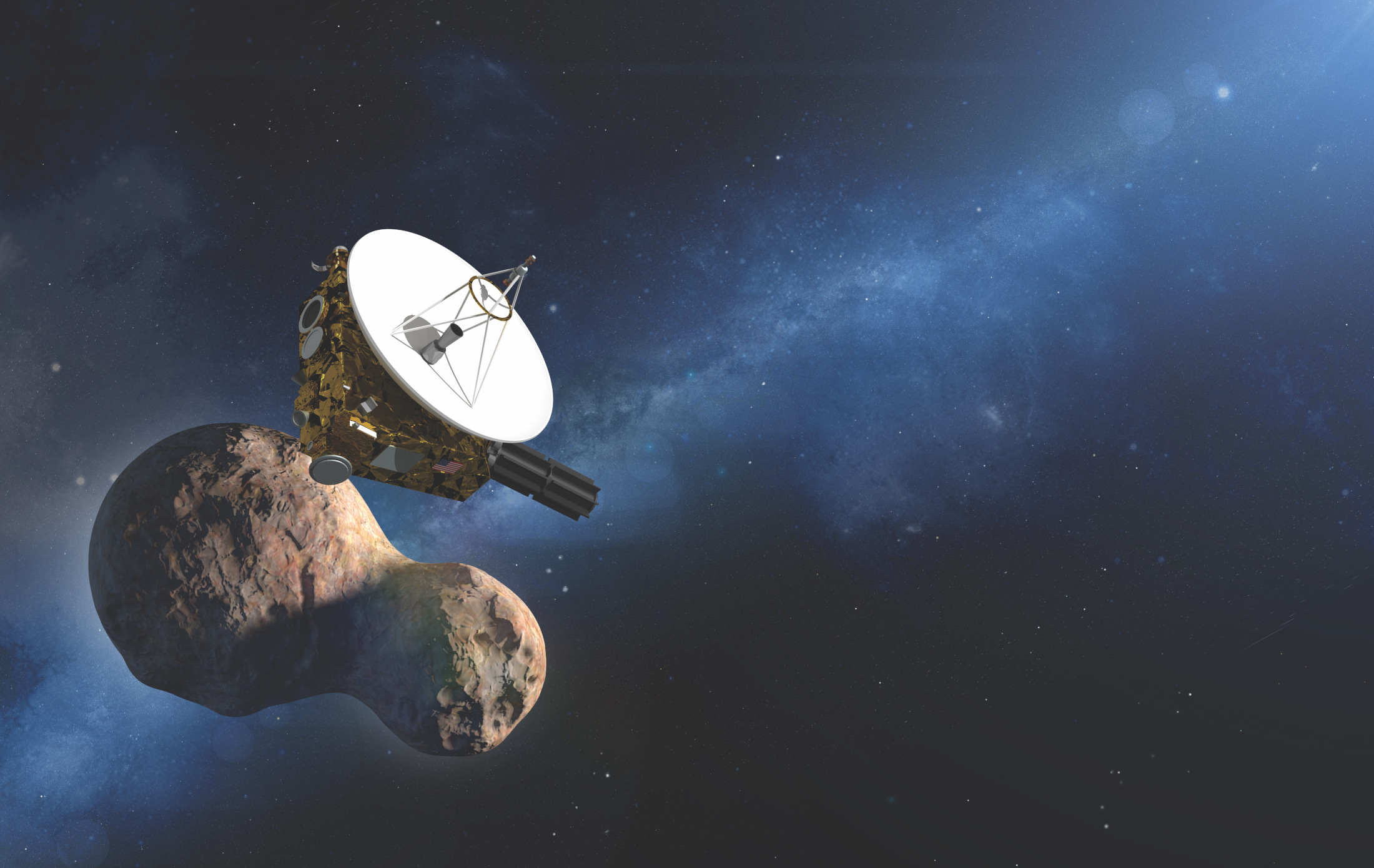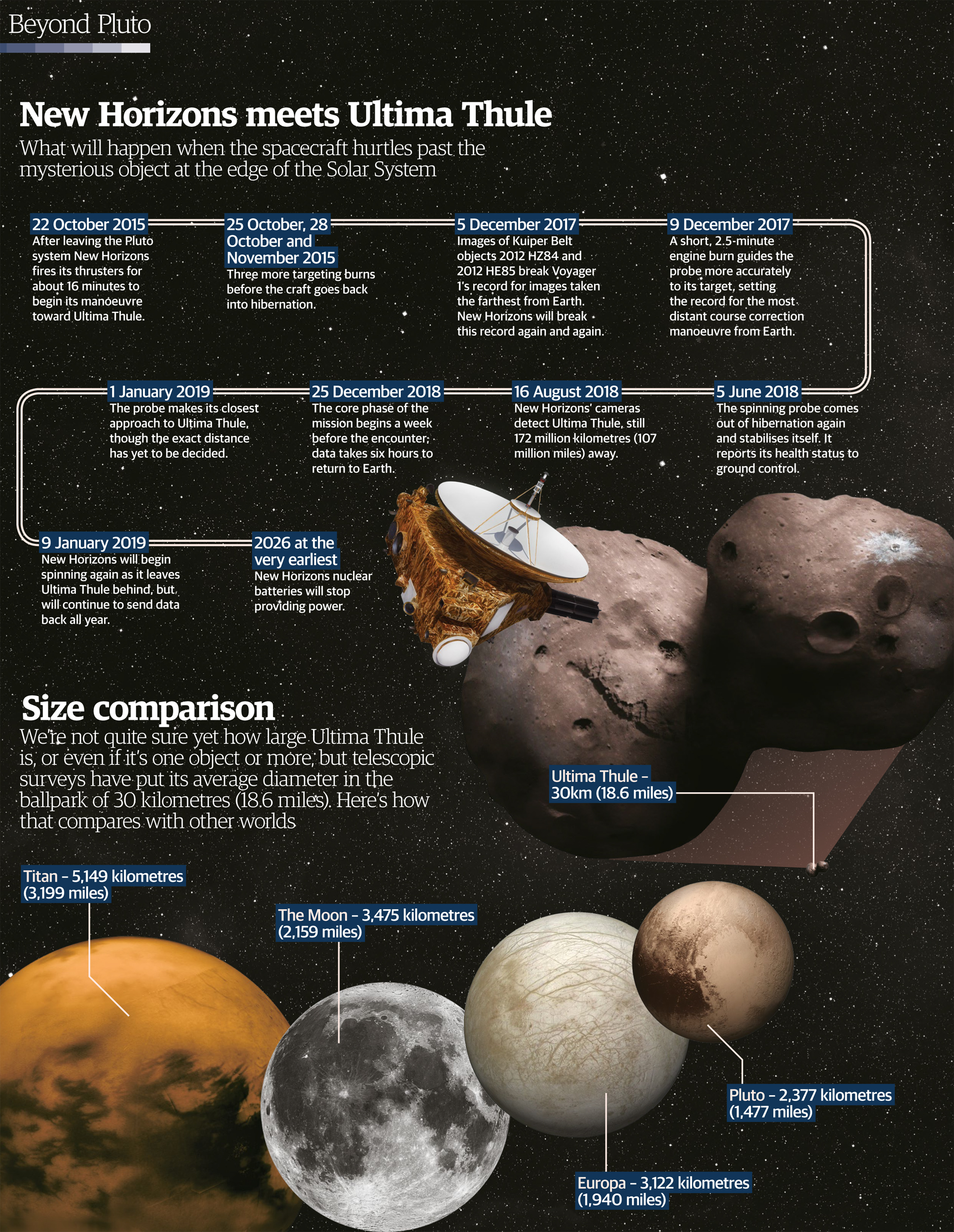New Horizons Beyond Pluto: What Lies in Ultima Thule's Realm?
The constellation of Sagittarius, the Archer, is a common sight in the winter sky, easily recognizable by the "teapot" asterism that makes up its front half. Look in the Archer's direction and you're staring into the center of the galaxy, the Milky Way contributing the "steam" from the teapot's spout.
With a home telescope you might see the Lagoon Nebula within Sagittarius, or a globular cluster such as Messier 54. If you have access to billions of dollars' worth of space telescope, however, you may discover other much smaller and fainter things.
This is just what happened in 2014 when the Hubble Space Telescope was surveying the area, hoping to find a new target for the New Horizons mission after ground-based telescopes had failed to find anything there. Back then, NASA's mission to Pluto was still incomplete, but it was clear the probe would be heading in the direction of Sagittarius following its encounter with the distant dwarf planet and, if an even more distant object were found in its path, it could carry on and encounter that, too. With plenty of plutonium dioxide on board to generate power, the probe is expected to keep functioning for many more years, time enough to explore the outer reaches of the solar system at over 36,040 mph (58,000 km/h). [How to Watch New Horizons' Ultima Thule Flyby]

The object Hubble discovered was named (486958) 2014 MU69. The number in parentheses is its minor planet number — we know of over half a million — while 2014 is the year of discovery. M is for the second half of June, and U69 indicates it's the 1,745th object discovered during those two weeks. Modern techniques and space telescopes are discovering a lot of objects. 2014 MU69 quickly picked up a nickname, Ultima Thule, as a result of a public vote. Thule, in Greek and Roman literature, was the farthest north you could go, often associated with Greenland or Iceland. The later addition of "Ultima," meaning "farthest," was used to mean a place beyond the borders of the world.
There are many thousands of unknown worlds out there at the borders of our solar system beyond the orbit of Neptune, but very few were in the right place to be visited by New Horizons. Collectively known as trans-Neptunian objects (TNOs), they're dimly lit and enormously spread out, with distances of 1 astronomical unit (AU) — the distance from the Earth to the sun — commonly between them. The best known, Pluto, is the most massive known object in an area of space between 30 and 55 AU from the sun, known as the Kuiper Belt.
We know of a few other big things in the belt — with two of them classified as dwarf planets like Pluto — and there's something heavier than Pluto too, the dwarf planet Eris. But Eris is three times farther from the sun than the demoted ninth planet and isn't classed as a Kuiper Belt object (KBO) thanks to its extreme distance — it falls into an area known as the Scattered Disc. Many scientists also believe there's evidence of a larger body in the orbits of smaller ones, but that hypothetical Planet Nine hasn't been seen yet.
An object generally needs a single-body diameter of at least 186 miles (300 kilometers) to be considered a dwarf planet. Most known KBOs are much smaller than Pluto's (1,477-mile (2,377 km) width, however. There's Lempo, a binary system with at least one additional satellite and a total diameter of around 249 miles (400 km), the same as Saturn's moon Mimas. Lempo is named after the god of love from Finnish mythology, and like a lot of KBOs appears extremely red. Then there's Drac, only 56 miles (90 km) across and named after Bram Stoker's famous count. Drac is notable because of its high inclination and the fact its orbit is retrograde — the opposite direction to most other objects. [Dwarf Planets: Science & Facts About the Solar System's Smaller Worlds]
Get the Space.com Newsletter
Breaking space news, the latest updates on rocket launches, skywatching events and more!
Ultima Thule could be a binary system too, but with a diameter of just 18.6 miles (30 km) or so it's a bit hard to make out from Earth. It was chosen as the new target because of its position — less fuel was required to reach it. A brighter, and therefore probably larger object was also considered, but the fuel needed to reach it would have left less in the tank for future maneuvering.
But why worry about something so small and far away? Studying KBOs like this tells us about the way the solar system was a long time ago. "The belt is analogous to the solar system's attic," said New Horizons principal investigator Alan Stern, of the Soutwest Research Institute in Boulder, Colorado.
"It's an ancient region, very far from the sun, which has been preserved in a deep freeze," Stern added. "It's the equivalent of an archaeological dig into the history and formation of the planets. So, scientifically it's a gold mine, and by going there with a spacecraft and observing KBOs up close, like we'll be doing with Ultima, we hope to learn a lot about how the early formation stages of the planets took place."
And that's not all, as the interactions of the small objects out there can tell us a lot about the movements of big objects. Really big ones. "What we know of the trans-Neptunian region is that it's the leftover remnants of the objects that didn't make it into being planets," said Michele Bannister, a post-doctoral researcher at Queen's University Belfast who helps discover minor planets as part of the Outer Solar System Origins Survey.
"These little rocky and icy worlds were formed in the initial disc of material around the sun, the ones that never grew up into being planets in their own right," Bannister said. "Since then, they've been sculpted by changes in the orbital positions of the giant planets, particularly Neptune."
The idea that planets move around rather than just placidly orbit the sun can be hard to process given the enormous size and mass of the outer planets, but according to the Nice model of solar system formation — named after the place in France, not merely because it's pleasing — as the solar system gathered together from its protoplanetary disc, everything formed much closer to the sun. The outer edge of the Kuiper Belt was once 30 AU from the sun instead of 55, and Uranus was the outer planet instead of Neptune. There's even a hypothesis that there could have been a fifth giant planet, ejected from the solar system following an encounter with Jupiter.
Gravitational interactions between the four giants we know of led to Neptune moving outward past the orbit of Uranus, producing the Kuiper Belt we see today. "What we see there today are materials from that initial disc," said Bannister. "Some of them are familiar, like water ice and rock, but some of them are unfamiliar, like kitchen cleaning chemicals you have under your sink, in solid form."
And even though it's called a belt, don't imagine it's completely flat. "A lot of the objects have never had anything happen to them; they're on round, flat orbits, but a lot of them have had energy put into them," Bannister said. "They can be a lot more eccentric; their orbits are long, thin ellipses, and they're tilted compared to the plane of the solar system. Some of them are in an orbital ballet with Neptune, called a mean motion resonance, where Neptune goes around the sun three times for every two times one of these objects goes round — that's the resonance Pluto is in. A lot of the objects are in places where they can do this, and that resonant objects exist at all when the spaces in between are free of objects is a signature that Neptune migrated outwards in the early solar system."
Ultima Thule is one of the less eccentric objects, and is not in a resonance with Neptune. Known as a "classical" KBO, it's also part of the "cold" population, which means it has never received any energy from collisions or gravitational interactions. It's just been sitting there, doing relatively little, since the solar system formed. Much of what we know about it comes from Hubble observations, or from occultations where the object passes in front of a background star. The dip in the star's brightness tells us about what's blocking it, and three occultations by Ultima Thule in 2017 were studied by a special group of astronomers formed by the New Horizons team. This study of occultations is the same process that is often used to observe exoplanets around distant stars, but even with this data Ultima Thule remains a mystery. [7 Ways to Discover Alien Planets]
"We don't know if it's two objects, or if it's binary, but we know its shape is not round," said Bannister. "Binary systems are very common in the population to which this little world belongs, and this ties directly into how they formed. A solar system starts off being made of dust and gas, and this starts forming little objects, and they have to get over about a meter in diameter and suddenly they're full-on asteroids that can start accreting material much, much faster. This whole process is something people are very actively working to understand, but binary objects might be implying that, when you initially make little worlds, you make them binary, so it tells us a lot about what physics to put into simulations of how planets are formed."

Whatever Ultima Thule is like, New Horizons is well equipped to tell us all about it, as the startling images of red-and-white plains and mountains on Pluto showed. "We have a very powerful set of seven scientific instruments," Stern said. "They will map its surface composition, search for an atmosphere, search for satellites, search for rings and make other kinds of studies. And I hope that we put together a very complete picture of what this typical Kuiper Belt object is like, because not only is this the first time that an object like this has been explored, but nobody's planning another mission out to the Kuiper Belt, so I think that this dataset is something that's going to be valuable scientifically for decades to come."
How long New Horizons can carry on sending back this kind of remarkable data is limited by the power and fuel supplies on the spacecraft, as well as the availability of suitable targets in its path. When you're travelling over 36,040 mph (58,000 kilometres), changing direction isn't easy.
Stern isn't worried about the future, however. "We have a very healthy spacecraft," he said. "We have the fuel and the power in our nuclear battery to run it for at least 15 years, maybe 20 years. If NASA continues to fund it, if NASA judges that it's scientifically worthwhile, this spacecraft will be operated into the mid-2030s or later. It's very much like the Voyagers which finished their exploration of the planets in the 1980s, but are still returning useful scientific data 40 years after launch."

This article was provided by Space.com's sister publication All About Space, a print magazine dedicated to astronomy, space exploration and the night sky. Sign up for the All About Space newsletter for news and subscription details! Follow us @Spacedotcom or Facebook. This version of the story published on Space.com.
Join our Space Forums to keep talking space on the latest missions, night sky and more! And if you have a news tip, correction or comment, let us know at: community@space.com.

Ian has been a journalist for over 20 years. He's written for magazines and websites on subjects such as astronomy, quantum physics, keeping fish, PC hardware, photo editing and gardening. Ian was also editor of Windows Help and Advice magazine and the Discover Science bookazines. In his spare time he has a pet tortoise and grows his own vegetables, but wishes he had more time for photography.










